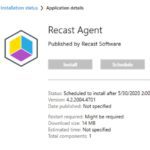Systems Management
Lessons Learned from Microsoft 365 Deployment with ConfigMgr: Part 4 – ConfigMgr Baseline
In this post I'm going to cover how we are using a ConfigMgr Baseline to control the user experience. I'm not suggesting everyone do it this way, but for us, we wanted to provide a good user experience, even to those on slow links, and make it look pretty while still looking legit, and native.
Gary Blok
May 29, 2020
























